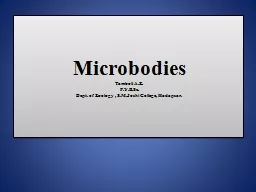PPT-Microbodies Tamboli A.Z.
Author : victoria | Published Date : 2022-06-07
FYBSc Dept of Zoology SMJoshi College Hadapsar Introduction Microbodies were first reported at the ultra structural level in the proximal convoluted tubule of mouse
Presentation Embed Code
Download Presentation
Download Presentation The PPT/PDF document "Microbodies Tamboli A.Z." is the property of its rightful owner. Permission is granted to download and print the materials on this website for personal, non-commercial use only, and to display it on your personal computer provided you do not modify the materials and that you retain all copyright notices contained in the materials. By downloading content from our website, you accept the terms of this agreement.
Microbodies Tamboli A.Z.: Transcript
Download Rules Of Document
"Microbodies Tamboli A.Z."The content belongs to its owner. You may download and print it for personal use, without modification, and keep all copyright notices. By downloading, you agree to these terms.
Related Documents

